Supernova
Stellar explosion that expels much or all of the stellar material with great force, driving a blast wavePropagating disturbance which transmits energy from one point to another without physically transporting the oscillating quantity. A wave is characterized by wavelength and frequency. into the surrounding space, and leaving a supernova remnant. Supernovae are classified based on the presence or absence of features in their optical spectra taken near maximum light. They were first categorized in 1941 by Rudolph Minkowski, who divided them into those that showed H in their spectra (Type II), and those that did not (Type I). Type I supernovae were further sub-divided in the 1980s based on the presence or absence of Si and He in their spectra. Type Ia supernovae have obvious Si absorptionTransfer of energy to a medium as a particle or electromagnetic radiation passes through it. Absorption of electromagnetic radiation is the combined result of Compton scattering, σ, and photoelectric absorption, τ. It may be quantified: where, t = thickness, ρ = density, and μ = mass absorption coefficient, which combines Compton and photoelectric effects (μ = σ + τ). Click on Term to Read More at 6150 Å. Type Ib have no Si but show He emission lines, and Type Ic display neither Si nor He.
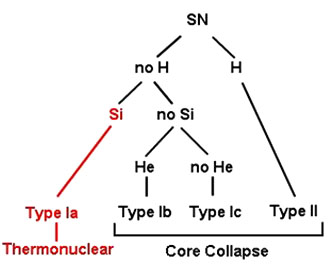
Image source: http://astronomy.swin.edu.au/cosmos/S/Supernova+Classification.
Type Ia supernovae can be found anywhere and in any type of galaxyConcentration of 106 to 1012 stars, dust and gas, that are gravitationally bound. Our galaxy contains ~2 × 1011 stars. There are four main types of galaxies: • Elliptical
• Lenticular
• Spiral
• Irregular
Click on Term to Read More, but Type Ib and Type Ic supernovae occur primarily in populations of massive stars, similar to Type IIs. It is now known that Type II, Type Ib and Type Ic supernovae result from the core-collapse of massive stars, while Type Ia supernovae are the thermonuclear explosions of white dwarfs.
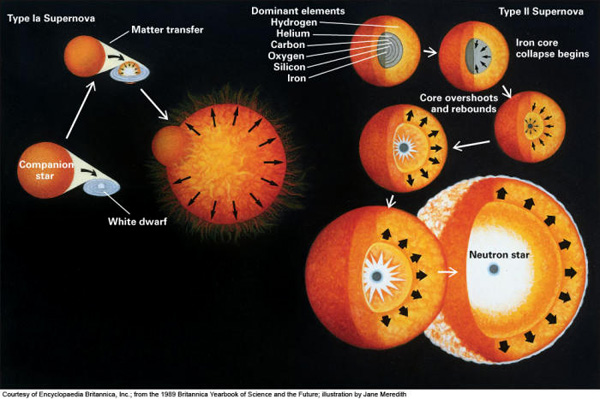
Image source: http://www.ifa.hawaii.edu/~barnes/ast110_06/tooe.html#[13].
Type Ia Supernova (snia)
Result of the explosion of a carbon-oxygen white dwarfRemnant of a star with mass <8 Msun. White dwarfs have masses <1.4 Msun (the Chandrasekhar mass) and are supported by electron degeneracy pressure. White dwarfs have radii ~Rearth (<0.02 Rsun) and densities ~105-6 g/cm3. No nuclear fusion or gravitational contraction occurs in white dwarfs, they shine by residual heat. in a binary systemDefinable part of the universe that can be open, closed, or isolated. An open system exchanges both matter and energy with its surroundings. A closed system can only exchange energy with its surroundings; it has walls through which heat can pass. An isolated system cannot exchange energy or matter with. They are the brightest of all supernovae with an absolute magnitudeMagnitude an object would have if placed at a distance of exactly 10 parsecs (= 32.6 light years). A supergiant star might have an absolute magnitude of -8 whereas a dim red dwarf might have an absolute magnitude of +16. The Sun has an absolute magnitude of +4.8 – about Click on Term to Read More of -19.5 at maximum light, occur in all galaxy types, and are characterized by a silicon absorption feature (rest wavelengthDistance from one peak of a wave to the next. Wavelength is measured in units of distance. The wavelengths of visible light correspond to ~400-650 nm. Wavelength is an important way to characterize a wave. For light, the shorter the wavelength, the higher the energy of the light wave. = 6355 angstroms) in their maximum light spectra. They can eject material at speeds of the order of 10,000 km/s and outshine an entire galaxy at their peak brightness.
Both the nature of Type Ia progenitors and the manner in which the starSelf-luminous object held together by its own self-gravity. Often refers to those objects which generate energy from nuclear reactions occurring at their cores, but may also be applied to stellar remnants such as neutron stars. explodes are still uncertain. It is generall accepted that as a white dwarf gains mass from its companion, it contracts and increases its temperature and densityMass of an object divided by its volume. Density is a characteristic property of a substance (rock vs. ice, e.g.). Some substances (like gases) are easily compressible and have different densities depending on how much pressure is exerted upon them. The Sun is composed of compressible gases and is much Click on Term to Read More. As the mass approaches the Chandrasekhar limit of 1.4 Msun, temperature and pressure in the interior of the star increase until a burning front forms, where C is fused into Fe and Ni almost instantaneously. However, iIf the accretionAccumulation of smaller objects into progressively larger bodies in the solar nebula leading to the eventual formation of asteroids, planetesimals and planets. The earliest accretion of the smallest particles was due to Van der Waals and electromagnetic forces. Further accretion continued by relatively low-velocity collisions of smaller bodies in the Click on Term to Read More model is right, the white dwarf ought to emit an abundance of X-raysHigh-energy electromagnetic radiation, with short wavelength (~10-0.01 nm) and high frequency (greater than ~1016 Hertz). Although the boundaries are somewhat arbitrary, wavelengths shorter than 0.01 nm are called gamma-rays and those longer than 10 nm extreme ultraviolet (EUV). X-rays would be produced by blackbody radiation at temperatures in excess of for ~10 million years before it explodes. Recent (2010) measurmeents reveal that X-ray emissions from five nearby elliptical galaxies and the central region of the Andromeda spiral galaxyGalaxy with spiral arms. These are classified based on their appearance in optical light, into those in which the arms radiated from a central bulge (classic spirals, S), and those where the arms radiated from a central bar (barred spirals, SB). Both types of spiral galaxies have a central bulge are one-thirtieth to one-fiftieth the amount expected in the accretion model. An alternative model is that type Ia supernovae form by merger of white dwarf stars.
The most popular theory is that the white dwarf undergoes a delayed detonation, where the burning front is initially subsonic (deflagration = “burning”) but later becomes supersonic (detonation). Observed explosion energies and observed amounts of unburnt C and O rule out a pure deflagration scenario. The fact that the whole star is not burnt to Fe and Ni rules out a pure detonation scenario. However, variations in explosion energies and the distributions of elements observed in Type Ia supernovae can be modeled by altering when the transition from deflagration to detonation occurs.
The B-band light curves of all SNIa look the same. There is an initial very rapid increase in luminosityBasic property used to characterize stars, luminosity is defined as the total energy radiated by a star each second. An object’s luminosity is often compared to that of the Sun (Lsun = 4 × 1033 ergs/s = 3.9 × 1026 Watts). Luminosity has the same units as power (energy per Click on Term to Read More, where the brightness of the supernova can change by up to 3 magnitudes in 15 days, that ends at maximum light. After reaching a maximum, brightness declines fairly rapidly (~0.087 mag/day) for the next 3–4 weeks. About a month after maximum light, the decline rate changes to a steady ~0.015 mag/day, dominated by the radioactive decayProcess in which an isotope's nucleus changes ('decays') to produce another isotope. The original atom is called the 'parent' and the resulting atom, the 'daughter'. There are three modes of radioactive decay: • Emission of a particle (He nucleus) that decreases the atomic number (Z) by 2 and the atomic Click on Term to Read More of 56Co.
Originally it was thought that every SNIa had the same peak brightness; although close to the truth, this is not quite correct. SNIa exhibit maximum brightnesses that range from about +1.5 to -1.5 magnitudes around a typical SNIa. The decline rate of the brightness after maximum light is correlated with the width of the maximum and the peak brightness of the supernova. Brightness can be standardized by applying the luminosity-decline rate relation. This is done using one of three light curve fitting techniques: the Δm15 method (shown below), the Multicoloured Light Curve Shapes method, or the Stretch method.
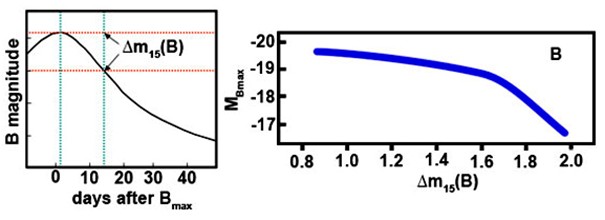
Image source: http://astronomy.swin.edu.au/cms/astro/cosmos/T/Type+Ia+Supernova+Light+Curves.
Each uses a standard or series of standard light curves to determine how under- or over-luminous a supernova compared to a “typical” SNIa. Astronomers then correct for the luminosity difference before using the supernova as a distance indicator. Consequently, SNIa are very precise distance indicators that can be observed over large distances. They have been instrumental in narrowing down the value of the Hubble Constant, and were the objects used to discover the accelerating universeThat which contains and subsumes all the laws of nature, and everything subject to those laws; the sum of all that exists physically, including matter, energy, physical laws, space, and time. Also, a cosmological model of the universe..
Type Ib Supernova (snib)
Type originally lumped with Type Ia (SNIa) and Type Ic (SNIc) supernovae due to the similar appearance of their light curves. Type Ib supernovae were recognized as a separate class based on the absence of the Si absorption feature typical of Type Ia spectra, and the presence of He absorption which is absent in Type Ic spectra at maximum light. In addition, late-time spectra of SNIb spectra are dominated by intermediate mass elements whereas SNIa spectra are dominated by heavy elements.
SNIb have much more in common with SNII and SNIc than SNIa. They are primarily found in arms of spiral galaxies close to HII regions, and emit radiation at radio wavelengths indicating that circumstellar material surrounded the progenitor star. Some SNII have been observed to transition to SNIb at late times. These observations lead to a model where SNIb result from the core-collapse of a massive star; the difference between SNII and SNIb is that the Type Ib progenitor lost its outer H layer before the collapse.
Type Ic Supernova (snic)
Supernova subtype recognized in 1987. Whereas, Type Ia supernova result from the explosion of a white dwarf, Types Ib and Ic supernovae result from core-collapse of a massive star and are similar to Type II supernovae (SNII). Some astronomers label both Type Ib supernova and SNIc supernova as SNIb/c, because they have similar light curves, spectral evolution and radio properties. The only observable difference between the two types is the lack of He in the spectra of SNIc.
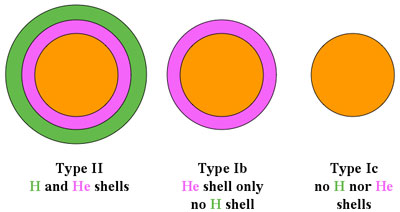
Image source: http://astronomy.swin.edu.au/cms/astro/cosmos/T/Type+Ic+Supernova.
Progenitor stars of SNIc are probably similar to those of SNII supernovae. However, whereas the progenitors of SNII retain H and He envelopes prior to explosion, and SNIb retain He envelopes, SNIc appear to have lost both, resulting in an almost featureless spectrum. The light curves of SNIc are very similar to those of SNIb and SNIa. Like SNIb, the light curves tend to be 1.0–1.5 magnitudes fainter than those of typical SNIa supernova. However, it is generally not possible to distinguish between SNIa, SNIb and SNIc based on light curve shape alone. Spectra (preferably at maximum light) are required to correctly classify new supernovae.
Type Ii Supernova (snii)
Explosive death of a >4 Msun star. Type II supernovae (SNII) were recognized as a distinct type of supernova in the early 1940s. They are distinguished by H emission lines in their spectra, and light curve shapes significantly different than those of Type I supernovae. SNII are sub-classified depending on whether their light curves show linear decline after the maximum (SNII-L) or a plateau phase where the brightness remains constant for an extended period of time (SNII-P). The peak brightnesses of all SNII are several magnitudes fainter than that of Type Ia supernovae. SNII-P show large variability in maximum brightness; peak brightnesses of SNII-L are nearly uniform at 2.5 magnitudes fainter than SNIa supernovae.
SNII are only found in regions of star formation, indicating that they result from core-collapse of massive stars. The difference between the three types of core-collapse supernovae is whether they have retained their outer envelopes of H and He before the explosion. The progenitors of SNII retain both H and He layers (progenitors of Type Ib supernovae have lost their H envelope but retain the He envelope; progenitors of Type Ic supernovae have lost both H and He envelopes before the core-collapse). Unlike Type Ia supernova, SNII tend to form shells of ejected stellar material around either a neutron starDense ball of neutrons that remains at the core of a star after a supernova explosion has destroyed the rest of a star with mass 8-18 (?) Msun. A neutron star has mass ~2-3 Msun, density ~1014 g/cm3, and is supported by neutron degeneracy pressure. Typical neutron stars are 10-20 Click on Term to Read More (coreIn the context of planetary formation, the core is the central region of a large differentiated asteroid, planet or moon and made up of denser materials than the surrounding mantle and crust. For example, the cores of the Earth, the terrestrial planets and differentiated asteroids are rich in metallic iron-nickel. Click on Term to Read More mass <3 Msun), or a black holeMaximally gravitationally collapsed object predicted to exist by the theory of general relativity, from which no material object, light or signal of any kind can escape. Many black holes form when a high mass supergiant star explodes in a supernova explosion at the end of its life. A star probably Click on Term to Read More. The ejected material is rich in heavy elements synthesized during the explosion, making SNII one of the principal sources for heavy elements in the Universe.
The first evidence that a core-collapse supernova has occurred is a massive burst of neutrinos. A shock waveAbrupt perturbation in the temperature, pressure and density of a solid, liquid or gas, that propagates faster than the speed of sound. emerges from the star a few hours later, releasing electromagnetic radiation initially as a UV flash. The supernova becomes visible at optical wavelengths as it expands. Brightness increases as the surface area increases combined with a relatively slow temperature decrease.
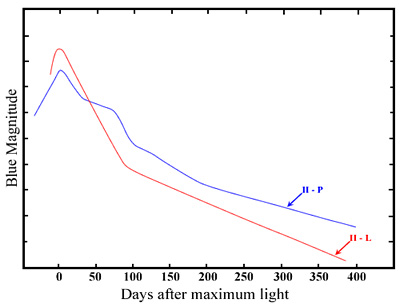
Image source: http://astronomy.swin.edu.au/cms/astro/cosmos/T/Type+II+Supernova+Light+Curves.
The peak in brightness occurs as temperature of the outer layers starts to decrease more rapidly. At this point, Type II supernovae may be divided into two classes based on the shape of their light curves. SNII-L (Linear) supernovae show a fairly rapid, linear decay after maximum light. SNII-P (Plateau) supernovae remain bright for an extended time after maximum. The lack of plateaus in SNII-L probably arises because SNII-L have much smaller hydrogenLightest and most common element in the universe (~92% by atoms; ~75% by mass). Hydrogen's isotopes are: • 1H (99.9885 %)
• 2H (0.0115 %), also called deuterium.
• 3H, also called Tritium, is a radioactive (t½ = 12.32 y) by-product of atmospheric thermonuclear tests in Earth's hydrosphere and atmosphere.
Click on Term to Read More envelopes than SNII-P. The peak brightness of SNII-L are nearly uniform at ~2.5 magnitudes fainter than a Type Ia supernova. However, the peak brightnesses of SNII-P show large variations due to differences in the radii of the progenitor stars. The end of the light curve is a radioactive tail, powered by the conversion of 56Co into 56Fe; it has the same shape for all core-collapse supernovae.






